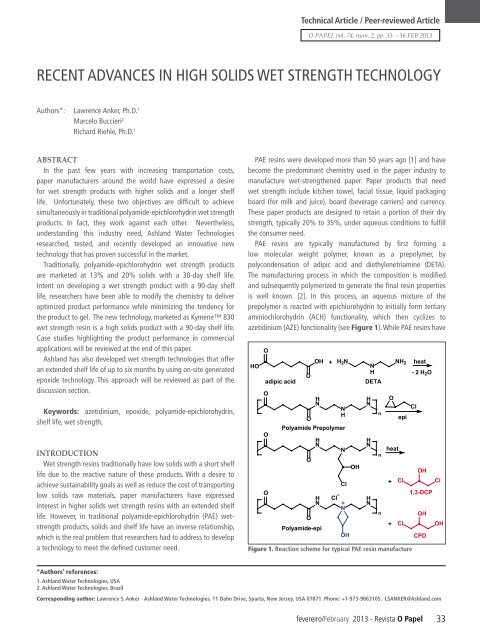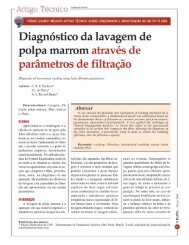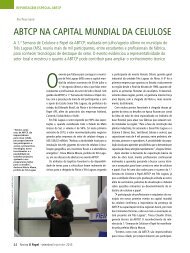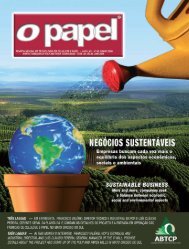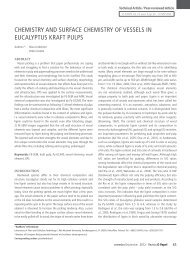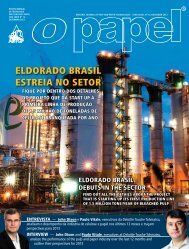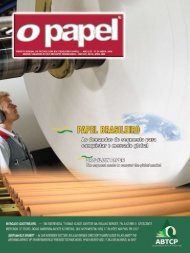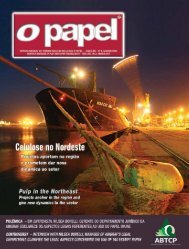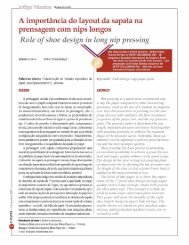A EVOLUÃÃO DA INDÃSTRIA DE CELULOSE E ... - Revista O Papel
A EVOLUÃÃO DA INDÃSTRIA DE CELULOSE E ... - Revista O Papel
A EVOLUÃÃO DA INDÃSTRIA DE CELULOSE E ... - Revista O Papel
You also want an ePaper? Increase the reach of your titles
YUMPU automatically turns print PDFs into web optimized ePapers that Google loves.
Technical Article / Peer-reviewed ArticleO PAPEL vol. 74, num. 2, pp. 33 - 36 FEB 2013RECENT ADVANCES IN HIGH SOLIDS WET STRENGTH TECHNOLOGYAuthors*: Lawrence Anker, Ph.D. 1Marcelo Buccieri 2Richard Riehle, Ph.D. 1ABSTRACTIn the past few years with increasing transportation costs,paper manufacturers around the world have expressed a desirefor wet strength products with higher solids and a longer shelflife. Unfortunately, these two objectives are difficult to achievesimultaneously in traditional polyamide-epichlorohydrin wet strengthproducts. In fact, they work against each other. Nevertheless,understanding this industry need, Ashland Water Technologiesresearched, tested, and recently developed an innovative newtechnology that has proven successful in the market.Traditionally, polyamide-epichlorohydrin wet strength productsare marketed at 13% and 20% solids with a 30-day shelf life.Intent on developing a wet strength product with a 90-day shelflife, researchers have been able to modify the chemistry to deliveroptimized product performance while minimizing the tendency forthe product to gel. The new technology, marketed as Kymene 830wet strength resin is a high solids product with a 90-day shelf life.Case studies highlighting the product performance in commercialapplications will be reviewed at the end of this paper.Ashland has also developed wet strength technologies that offeran extended shelf life of up to six months by using on-site generatedepoxide technology. This approach will be reviewed as part of thediscussion section.PAE resins were developed more than 50 years ago [1] and havebecome the predominant chemistry used in the paper industry tomanufacture wet-strengthened paper. Paper products that needwet strength include kitchen towel, facial tissue, liquid packagingboard (for milk and juice), board (beverage carriers) and currency.These paper products are designed to retain a portion of their drystrength, typically 20% to 35%, under aqueous conditions to fulfillthe consumer need.PAE resins are typically manufactured by first forming alow molecular weight polymer, known as a prepolymer, bypolycondensation of adipic acid and diethylenetriamine (<strong>DE</strong>TA).The manufacturing process in which the composition is modifiedand subsequently polymerized to generate the final resin propertiesis well known. [2]. In this process, an aqueous mixture of theprepolymer is reacted with epichlorohydrin to initially form tertiaryaminiochlorohydrin (ACH) functionality, which then cyclizes toazetidinium (AZE) functionality (see Figure 1). While PAE resins haveKeywords: azetidinium, epoxide, polyamide-epichlorohydrin,shelf life, wet strength,INTRODUCTIONWet strength resins traditionally have low solids with a short shelflife due to the reactive nature of these products. With a desire toachieve sustainability goals as well as reduce the cost of transportinglow solids raw materials, paper manufacturers have expressedinterest in higher solids wet strength resins with an extended shelflife. However, in traditional polyamide-epichlorohydrin (PAE) wetstrengthproducts, solids and shelf life have an inverse relationship,which is the real problem that researchers had to address to developa technology to meet the defined customer need.Figure 1. Reaction scheme for typical PAE resin manufacture*Authors’ references:1. Ashland Water Technologies, USA2. Ashland Water Technologies, BrazilCorresponding author: Lawrence S. Anker - Ashland Water Technologies. 11 Dahn Drive, Sparta, New Jersey, USA 07871. Phone: +1-973-9063105. LSANKER@Ashland.comfevereiro/February 2013 - <strong>Revista</strong> O <strong>Papel</strong>33


